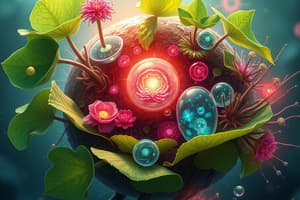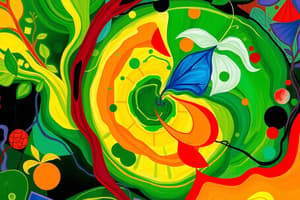Podcast
Questions and Answers
What form of energy is captured during photosynthesis?
What form of energy is captured during photosynthesis?
- Nuclear energy
- Chemical energy (correct)
- Kinetic energy
- Thermal energy
Which molecules are used to convert carbon dioxide to hexose phosphates during photosynthesis?
Which molecules are used to convert carbon dioxide to hexose phosphates during photosynthesis?
- ATP and NADPH (correct)
- GTP and NADH
- AMP and NADH
- ADP and NADP+
What is the primary role of phototrophs in an ecosystem?
What is the primary role of phototrophs in an ecosystem?
- Converting solar energy into chemical energy (correct)
- Recycling nutrients from dead organisms
- Decomposing organic matter
- Consuming other organisms
Where do the light-dependent reactions of photosynthesis take place?
Where do the light-dependent reactions of photosynthesis take place?
What is the primary function of the hydride ion (H:-) during the light-dependent reactions?
What is the primary function of the hydride ion (H:-) during the light-dependent reactions?
Which of the following occurs during the dark (light-independent) reactions of photosynthesis?
Which of the following occurs during the dark (light-independent) reactions of photosynthesis?
What is the typical diameter of a chloroplast?
What is the typical diameter of a chloroplast?
What is the role of chlorophyll in photosynthesis?
What is the role of chlorophyll in photosynthesis?
Which metal ion is found within the tetrapyrrole ring of chlorophyll?
Which metal ion is found within the tetrapyrrole ring of chlorophyll?
What is the primary role of antenna pigments in photosynthesis?
What is the primary role of antenna pigments in photosynthesis?
What connects Photosystem I (PSI) and Photosystem II (PSII) in the light-dependent reactions of photosynthesis?
What connects Photosystem I (PSI) and Photosystem II (PSII) in the light-dependent reactions of photosynthesis?
At which wavelength does P700, the reaction center chlorophyll in Photosystem I (PSI), absorb light maximally?
At which wavelength does P700, the reaction center chlorophyll in Photosystem I (PSI), absorb light maximally?
What is the role of light energy in the Z-scheme of photosynthesis?
What is the role of light energy in the Z-scheme of photosynthesis?
During the oxidation of 2 water molecules (2 H2O) in photosynthesis, how many molecules of NADPH are produced?
During the oxidation of 2 water molecules (2 H2O) in photosynthesis, how many molecules of NADPH are produced?
What is the electrochemical gradient (ΔµH) primarily composed of?
What is the electrochemical gradient (ΔµH) primarily composed of?
What is the function of the CFo portion of the chloroplast ATP synthase?
What is the function of the CFo portion of the chloroplast ATP synthase?
How many ATP and NADPH molecules are required for each CO2 molecule to be reduced to (CH2O) in carbohydrate synthesis?
How many ATP and NADPH molecules are required for each CO2 molecule to be reduced to (CH2O) in carbohydrate synthesis?
What is the primary purpose of cyclic electron transport in photosynthesis?
What is the primary purpose of cyclic electron transport in photosynthesis?
In cyclic electron flow, which molecule donates electrons back to the plastoquinone (PQ) pool?
In cyclic electron flow, which molecule donates electrons back to the plastoquinone (PQ) pool?
What is the ultimate fate of the proton gradient (µH) generated during the light-dependent reactions of photosynthesis?
What is the ultimate fate of the proton gradient (µH) generated during the light-dependent reactions of photosynthesis?
Which of the following best describes the role of light in photosynthesis?
Which of the following best describes the role of light in photosynthesis?
Which of the following is the main role of light reactions in photosynthesis?
Which of the following is the main role of light reactions in photosynthesis?
Flashcards
Photosynthesis
Photosynthesis
Process converting CO2 and H2O into carbohydrates using solar energy.
Light Reactions
Light Reactions
Membrane-bound reactions capturing solar energy, producing O2, ATP, and NADPH.
Dark Reactions
Dark Reactions
Light-independent reactions that convert CO2 into carbohydrates using ATP and NADPH.
Chloroplast Structure
Chloroplast Structure
Signup and view all the flashcards
Chemiosmosis
Chemiosmosis
Signup and view all the flashcards
Chlorophyll
Chlorophyll
Signup and view all the flashcards
NADPH
NADPH
Signup and view all the flashcards
Z Scheme
Z Scheme
Signup and view all the flashcards
Bacteriochlorophyll
Bacteriochlorophyll
Signup and view all the flashcards
Antenna pigments
Antenna pigments
Signup and view all the flashcards
Photosystem I (PSI)
Photosystem I (PSI)
Signup and view all the flashcards
Photosystem II (PSII)
Photosystem II (PSII)
Signup and view all the flashcards
Photophosphorylation
Photophosphorylation
Signup and view all the flashcards
Cyclic electron flow
Cyclic electron flow
Signup and view all the flashcards
ATP synthase
ATP synthase
Signup and view all the flashcards
Thylakoid membrane
Thylakoid membrane
Signup and view all the flashcards
Proton motive force (PMF)
Proton motive force (PMF)
Signup and view all the flashcards
Study Notes
Photosynthesis Overview
- Photosynthesis is a process converting atmospheric carbon dioxide (CO2) and water (H2O) into carbohydrates.
- Solar energy is captured as ATP and NADPH.
- ATP and NADPH are used to convert carbon dioxide to hexose phosphates.
- Phototrophs are photosynthetic organisms, including some bacteria, algae, and higher plants.
Photosynthesis 1 - Light Reactions
- Light and dark reactions are parts of photosynthesis.
- Light energy is captured for biochemical processes.
- Specific light wavelengths are important for photosynthesis.
- Photosynthesis takes place in chloroplasts.
- The Z-scheme is a model of the electron flow in light reactions.
Light Reactions and Dark Reactions
- Light-dependent reactions are membrane-bound.
- Light reactions release oxygen from water molecules.
- Light reactions produce ATP and NADPH.
- Dark reactions occur in the solution (stroma).
- Dark reactions convert carbon dioxide to carbohydrates.
- Dark reactions use energy from NADPH and ATP.
Chloroplast Structure
- Chloroplasts are 4-8 mm diameter organelles in plant cells.
- Chloroplasts have two surrounding membranes.
- Internal membranes are stacked as thylakoid membranes.
- Thylakoids are stacked into grana.
- The space surrounding the thylakoids is called stroma.
Chlorophyll and Other Pigments
- Chlorophyll is a major, abundant light-harvesting pigment.
- Tetrapyrrole ring structure is similar to heme but with magnesium (Mg2+) instead of iron.
- Other pigments like carotenoids, phycoerythrin, and phycocyanin are antenna pigments.
- Antenna pigments capture light energy, especially in the green spectrum.
- Antenna pigments transfer light energy to chlorophylls.
Light Absorption and Photosystems
- Light absorption occurs in two photosystems (PSI and PSII).
- Photosystems are groups of proteins and pigments in the thylakoid membrane.
- PSI is paired for P700 (absorbs light maximally at 700 nm).
- PSII is paired for P680 (absorbs light maximally at 680 nm).
- A Z-scheme model illustrates the electron flow.
- PSII to PSI to NADP+.
Z-Scheme
- Z-scheme describes the path of electron flow and reduction potentials of components in photosynthesis.
- Light energy converts P680 and P700 to excited molecules that are better electron donors.
- Electron flow drives electron transfer uphill.
- NADP+ is the final electron acceptor.
- Water is oxidized to produce oxygen (O2), while NADPH is produced.
Chemiosmosis
- Chemiosmosis theory explains energy conversion during photosynthesis.
- The formation of a transmembrane electrochemical gradient is key.
- Protons (H+) are transferred across a membrane to create this gradient.
- The gradient is used to drive protons through ATP synthase.
- ATP synthase creates ATP from ADP and Pi.
Photophosphorylation — H+ ATP Synthase
- Photophosphorylation is an ATP synthesis process dependent on light energy.
- Chloroplast ATP synthase has two major parts, CF0 and CF1.
- CF0 spans the membrane, acting as a proton channel.
- CF1 protrudes into the stroma, catalyzing ATP synthesis.
- ATP is made from ADP and Pi.
Cyclic Electron Flow and Phosphorylation
- Cyclic electron flow produces ATP, bypassing NADPH production.
- Energy for CO2 reduction generates 2 NADPH and 3ATP.
- Cyclic flow increases proton motive force for greater ATP production.
Summary of Photosynthesis
- Photosynthesis uses light energy to fix carbon into sugar.
- Light reactions capture light energy to reduce NADP+ and phosphorylate ADP.
- Photosynthesis takes place in chloroplasts.
- ATP and NADPH are the energy sources for cellular reactions.
Studying That Suits You
Use AI to generate personalized quizzes and flashcards to suit your learning preferences.




